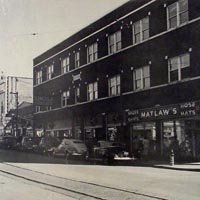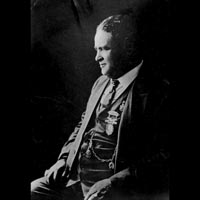Kansas City's distinctive style of jazz evolved from blues, ragtime and concert band music spawned in the ![]() 18th and Vine area. In the days of public segregation, 18th and Vine served as a
18th and Vine area. In the days of public segregation, 18th and Vine served as a ![]() business and
business and ![]() social hub for the African-American community. Established in the late-1800s, 18th and Vine (originally known as the Bowery) provided residents with the
social hub for the African-American community. Established in the late-1800s, 18th and Vine (originally known as the Bowery) provided residents with the ![]() services and goods they were denied downtown.
services and goods they were denied downtown. ![]() Fire stations,
Fire stations, ![]() grocery stores,
grocery stores, ![]() pharmacies,
pharmacies, ![]() hotels, fish shops and other small
hotels, fish shops and other small ![]() businesses crowded the
businesses crowded the ![]() intersection of 18th and Vine streets, located one half mile southeast of downtown Kansas City. Social activities whirled around the dance halls, theaters and cabarets scattered liberally throughout the district. During the summer crowds flocked to Lincoln Electric Park, an Edison wonderland modeled after the larger
intersection of 18th and Vine streets, located one half mile southeast of downtown Kansas City. Social activities whirled around the dance halls, theaters and cabarets scattered liberally throughout the district. During the summer crowds flocked to Lincoln Electric Park, an Edison wonderland modeled after the larger ![]() Electric Park across town. Music permeated the area.
Electric Park across town. Music permeated the area.
The Great Western, Dude Knox, Fountain B. Woods, ![]() Criterion and
Criterion and ![]() Williams orchestras, along with the Ladies Band led by trumpeter
Williams orchestras, along with the Ladies Band led by trumpeter ![]() Josie Williams and other
Josie Williams and other ![]() early orchestras performed ragtime, light classical and popular standards at dances and other social events. Blind blues shouters preached the blues on street corners.
early orchestras performed ragtime, light classical and popular standards at dances and other social events. Blind blues shouters preached the blues on street corners. ![]() Brothers Mulles, Miles and Millus Pruit played the blues on string instruments at house parties and saloons with sawdust floors. The form and feel of the blues provided a firm foundation for Kansas City jazz style.
Brothers Mulles, Miles and Millus Pruit played the blues on string instruments at house parties and saloons with sawdust floors. The form and feel of the blues provided a firm foundation for Kansas City jazz style.
Band leader Dan Blackburn along with educators Major N. Clark Smith and Professor Charles T. Watts organized full-sized concert bands, performing a challenging repertoire of classical music. Bennie Moten and other first generation jazz musicians cut their teeth as members of Blackburn's kid band. Students of Watts and Smith mastered their instruments and musical theory, enabling them to become confident soloists.
Blind Boone, a piano pioneer based in Columbia, Missouri frequently played concerts in Kansas City. Primarily a concert pianist, Boone, according to ragtime scholar Dave Jasen, occasionally put "the cookies on the lower shelf where everyone can reach them," and performed standards in "ragged time." Ragtime composer ![]() James Scott conducted bands at the Eblon and Lincoln theaters. Scott, Boone and other ragtime professors introduced the syncopation that rhythmically distinguished Kansas City jazz.
James Scott conducted bands at the Eblon and Lincoln theaters. Scott, Boone and other ragtime professors introduced the syncopation that rhythmically distinguished Kansas City jazz.
Drawing from these influences, the members of Colored Musicians' Local 627, affiliated with the American Federation of Musicians, created Kansas City jazz style.



